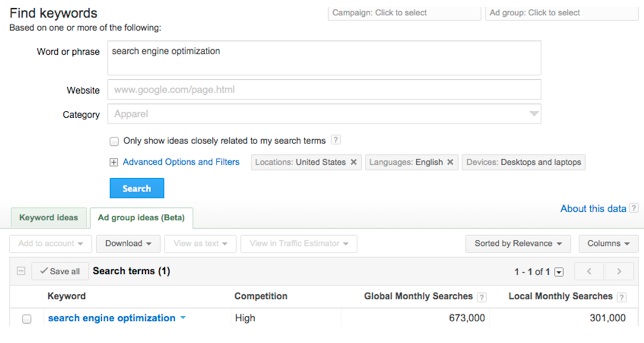 Knowing how to optimize content for search engines is essential, but often easier said than done. After all, mastering the art and science of search engine optimization (SEO) is no small feat.
Knowing how to optimize content for search engines is essential, but often easier said than done. After all, mastering the art and science of search engine optimization (SEO) is no small feat.
Frequent updates to Google’s search ranking algorithm — notably Panda and Penguin — only complicate matters. Although such updates go a long way toward enhancing the quality of search results by, for example, discounting the high volumes of low-quality content produced by content farms, they also mean that the best ways to optimize content are constantly evolving.
Simply put, you’ve got to stay on your toes when it comes to SEO content. Fortunately for those of us who aren’t in the habit of analyzing search engine algorithms but still want to optimize content, there are some basic tips that are easy to follow.
In the interest of full disclosure, let me make it clear that I’m in no way, shape, or form an SEO expert. If you’re looking for the definitive word on the subject, there are far more comprehensive resources on the subject (such as this guide by SEOmoz). If, however, you’re new to SEO and are looking for some simple techniques to optimize SEO content for search engines, written in plain language, read on!
How to optimize content: The 411 on keywords
At its most basic, SEO is about tinkering with your content to make it attractive to search engines. One way of doing this is by selecting the right keyword — the word or phrase that people would be most likely to enter into a search engine if they were looking for your content — and then using it throughout what you write. When Google indexes your website, it detects the keywords you’ve used and how you’ve used them, and ranks your content (in part) on that basis. That ranking is what determines if your content shows up on the first page of results when you google the keyword or on the fifty-first.
Of course, not all keywords are created equal. You’ve got to take care in choosing the ones that you’ll have the greatest chances of ranking well for. Many are highly competitive, so vetting your options is essential. Plus, what seems like the right keyword to you, may not be what people actually use to search for content. After all, what good is using “early stage companies” if most people are searching for “start-ups.” Understanding context is one key for creating SEO content.
Not to worry. You are not alone in your quest to optimize content. You can consult the free Google Adwords Keyword Tool to get some insights. Type in a potential keyword and the site tells you how many people are searching for it in a given month and how much competition there is, based on advertising spend for sponsored links. Armed with this data, you can do a reasonable job of picking a keyword.
Take this article as an example. Although I’m writing about “search engine optimization,” the keyword tool quickly reveals that it’s not a good choice for use as SEO content.
With more than 600,000 global monthly searches and a competition rating of high, I’ve got no chance of ranking for it. Looking at who is ranking on page one for this keyword — big names (SEOmoz), with sites that drive huge traffic — confirms that assessment.
After experimenting with other options, I discover that “optimize content” is a much better option. It still gets at the same idea as search engine optimization, but has a low competition ranking and garners about 1,900 global searches a month. While there are still some pretty big names on the first page of results for the term, my chances of winding up there too are much greater using “optimize content” than if I selected “search engine optimization” as my keyword.
Now you may be thinking that 1,900 hits a month is nothing compared to 600,000. True enough. However, if you can rank on page 1 for those 1,900 hits and consistently drive a portion of them to your site, you’re going to be much better off than if you rank on page 51 for the 600,000 hits and never get found.
Importantly, it was only after I had “optimize content” as my keyword, that I began writing this article. It’s much easier to create content with a keyword in mind than trying to retrofit it into something you’ve already crafted. All the more so because, as with any keyword, I need to use “optimize content” in context, not just willy-nilly, in order to help my ranking.
For reference, I’ve highlighted my use of my keyword optimize content throughout this article to show you how I used it. Some of the things to keep in mind when incorporating a keyword are to include it in:
- The title of your content
- The first sentence of your first paragraph
- At least one heading within the content
- The page’s URL
- The page’s meta description
- The alternate text field of any images you’ve included
Ultimately, you want to use your keyword enough for it to catch the attention of search engines, while still being sensible. Expert opinions vary, but the general rule of thumb is to aim for a keyword density — the percentage of times the keyword appears in your content compared to the total number of words — of between 1 percent and 3 percent. The keyword density of this article, FYI, is 1.23 percent.
Tip: To learn a lot more about keywords, check out “Better Keywords, Better Customers: A Business Guide to Keyword Generation.”
How to optimize content: other factors
If you’re creating your content in WordPress, consider using the SEO Yoast Tool, which analyzes how SEO-friendly your content is. The tool gives you ratings of green (good to go), yellow (hold up, you can do better), and red (stop, you’re off track!) across a variety of content optimization dimensions. In addition to telling you your keyword density, it checks to see if you’ve included keywords in the places noted above and if you’ve met a host of other guidelines.
The tool also checks out some other important factors that you need to bear in mind as you look to optimize content. Namely, it looks to ensure that your content:
- Is at least 300 words in length
- Contains outbound links
- Has a relatively short URL
- Is easy to read, with concise sentences.
When I ran this article through the tool, I got the following result:
Overall, I’ve done a good job of optimizing this article for search engines. There are a couple of things I could adjust, but the mostly green lights tell me I’m ready to publish.
To be clear, there is a lot more to ranking well on search engines than optimizing your content. Google also looks at how much your content is shared, how many inbound links it has, and much more with its algorithm. That said, if you don’t know Jack about SEO, the tips above will go a long way toward helping as you look to optimize content!
Want more content marketing inspiration? Download our ultimate eBook with 100 content marketing examples.
Image via Bigstock


